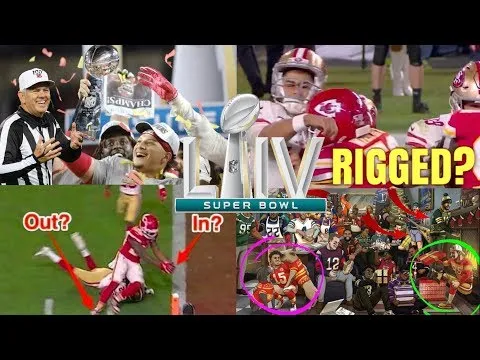Hi Everyone,

In early November 2019, I made a Super Bowl prediction in my post My Super Bowl Prediction. I predicted that the San Francisco 49ers would defeat the New England Patriots. I got the part about the 49ers making the Super Bowl correct but instead they lost. I was completely wrong about the Patriots; the Tennessee Titans eliminated them in the Wild Card round. The Kansas City Chiefs made the Super Bowl and won it.
It is very difficult to predict which teams are going to reach the Super Bowl. The league is structured to prevent any particular team from dominating each season. However, the New England Patriots have been an exception to this by winning 6 Super Bowls in the past two decades. The betting/gambling industry profit from the NFL being unpredictable. I have seen several videos where people have attempted to predict which teams would reach and win the Super Bowl using Gematria. I believe it is a little implausible that games could be orchestrated to such an extent that so many elements could have a hidden meaning. Instead, in this post, I will discuss how games might be manipulated and explain the likely incentive to do so.
The incentives to orchestrate
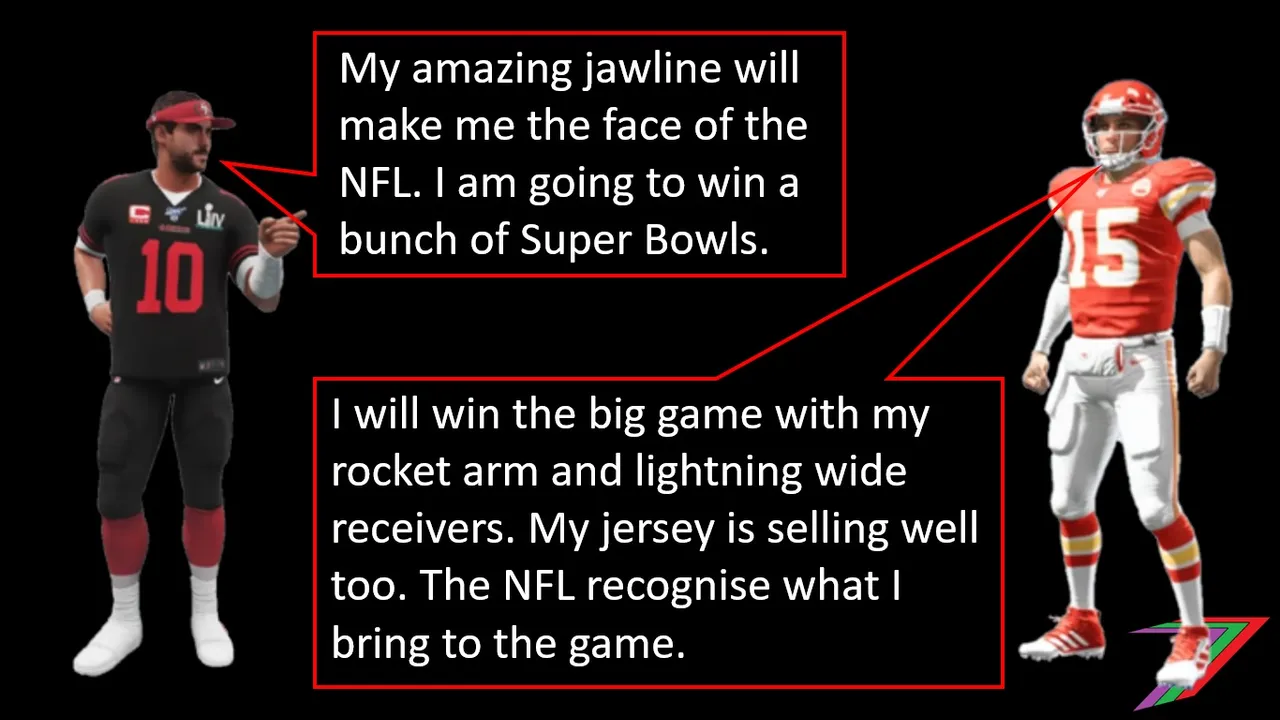
NFL teams, like most other organisations, are predominantly profit driven. For a team to be profitable, its revenue needs to exceed its costs. Typically, the more successful a team becomes, the more revenue it should earn. Success attracts more supporters who watch more games either at the stadium (buying tickets) or from home (team indirectly earns advertising revenue). Teams also profit from supporters buying merchandise and food and beverages.
For NFL teams it is a little different. NFL teams earn largely through a shared revenue pool. This revenue pool consists of revenue from television and media as well as a share from tickets (40% from each game (Shared Revenue)) and merchandise. In 2018, the NFL shared revenue amounted to US$8.87 Billion (Action Network), that is US$274.3 Million per team. The Dallas Cowboys have a different arrangement with the NFL in regards to merchandise. They have been allowed to keep profits without needing to share with the rest of the league (Forbes). Figure 1 contains the NFL shared revenue from 2011 to 2018.
Figure 1: NFL shared revenue (2011 – 2018)
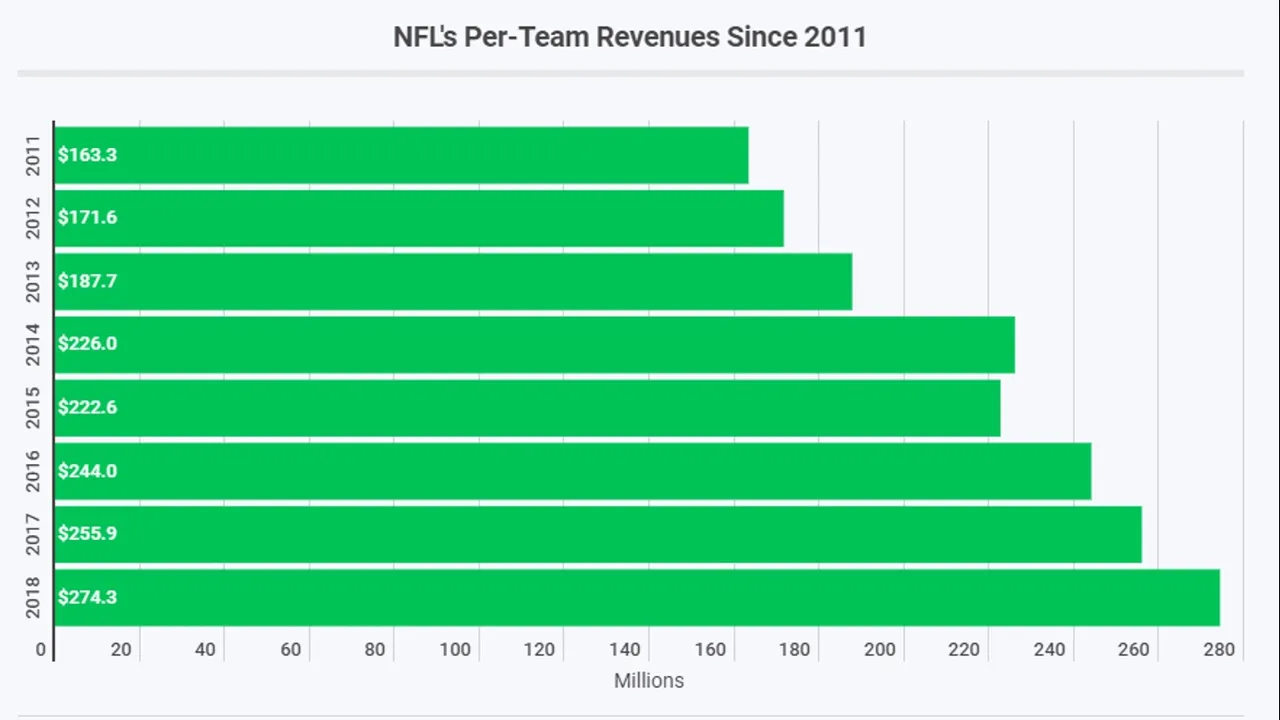
Source: Action Network
In regards to costs, the NFL has an annual salary cap. In 2019, the salary cap was US$188.2 Million (nfl.com). The salary cap is considerably lower than what each team received in shared revenue in 2018. It should also be noted that not every team uses the full salary cap each season. A team has other costs but I do not have these details. The Green Bay Packers are the only NFL team to publish financial information (sportsbusinessdaily.com). If we consider the Packers cost structure to be representative of other team's cost structures, player salaries make up the bulk of team expenses. The Packers are consistently profitable but only marginally in 2019 (Cheese Head TV).
A teams profit is more closely linked to the success of the league as a whole than their own individual performance. For example, the Carolina Panthers have consistently received over 60% of their revenue from the shared revenue pool. In 2018, this percentage increased to almost 65%. However, revenue does not appear affected by the team’s performance during the season. Figure 2 contains the Panthers revenue and NFL regular season records from 2001 to 2018.
Figure 2: Carolina Panthers Revenue and Performance (2001 – 2018)
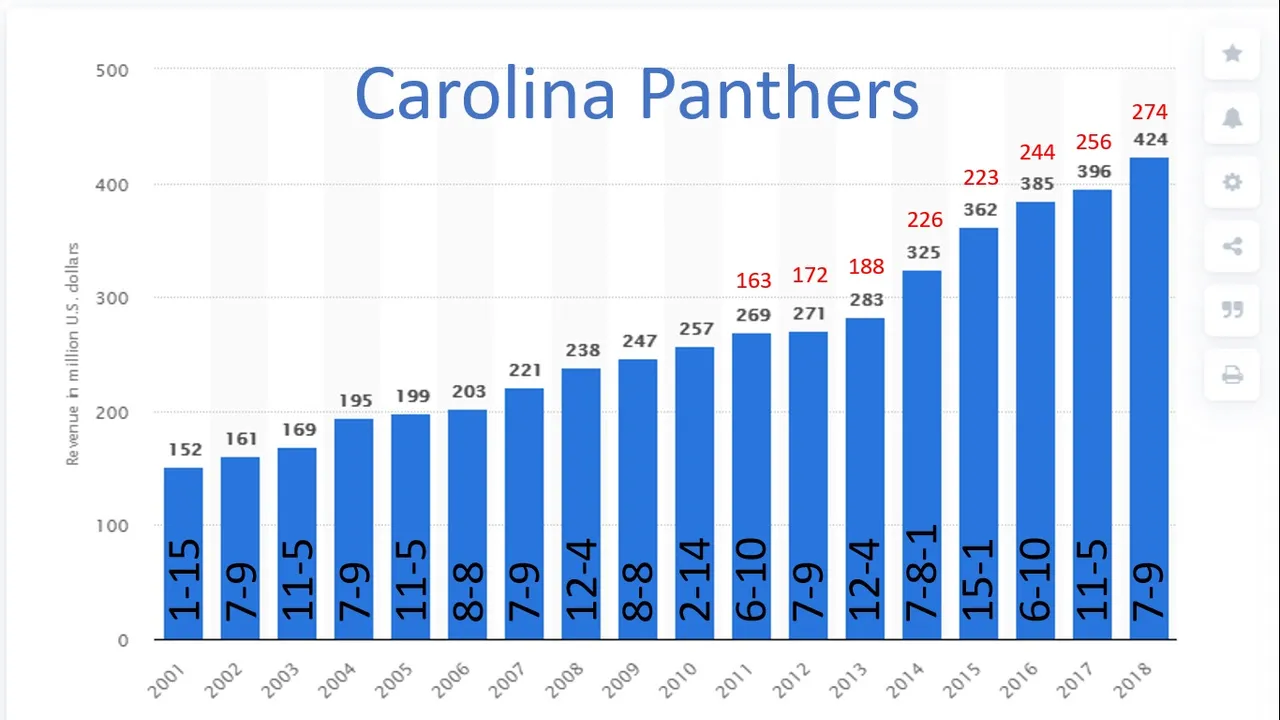
Source: Statista
Note: NFL shared revenue in red. Team record at the bottom of each bar.
Another example is the New England Patriots. The Patriots have dominated for two decades and have been especially dominant between 2014 and 2018; appearing in 4 of 5 Super Bowls. However, the NFL shared revenue pool makes up over 40% of the team’s revenue and surpassed 45% in 2018 despite the team’s amazing performance during that period. The NFL as a whole was outperforming the Patriots in terms of increasing revenue. Figure 3 contains the Patriots revenue and NFL regular season records from 2001 to 2018.
Figure 3: New England Patriots Revenue and Performance (2001 – 2018)

Source: Statista
In Figure 3, I highlighted 2002. In 2002, The New England Patriots Gillette Stadium was opened (gillettestadium.com). In 2002, the New England Patriots experienced the largest percentage increase in revenue (39% increase) from their two decades of dominance. It appears the new stadium contributed more to revenue than the performance of the team.
I looked at the revenue from three teams with recently opened stadiums to see if they experienced the same jump in revenue. These teams are:
- The San Francisco 49ers with Levi’s Stadium (Figure 4)
- Minnesota Vikings with U.S. Bank Stadium (Figure 5)
- Atlanta Falcons with Mercedes-Benz Stadium (Figure 6)
Figure 4: San Francisco 49ers Revenue and Performance (2001 – 2018)

Source: Statista
Note: Year in red represents the year the stadium was announced. Year in green represents the year the stadium was completed.
Figure 5: Minnesota Vikings Revenue and Performance (2001 – 2018)
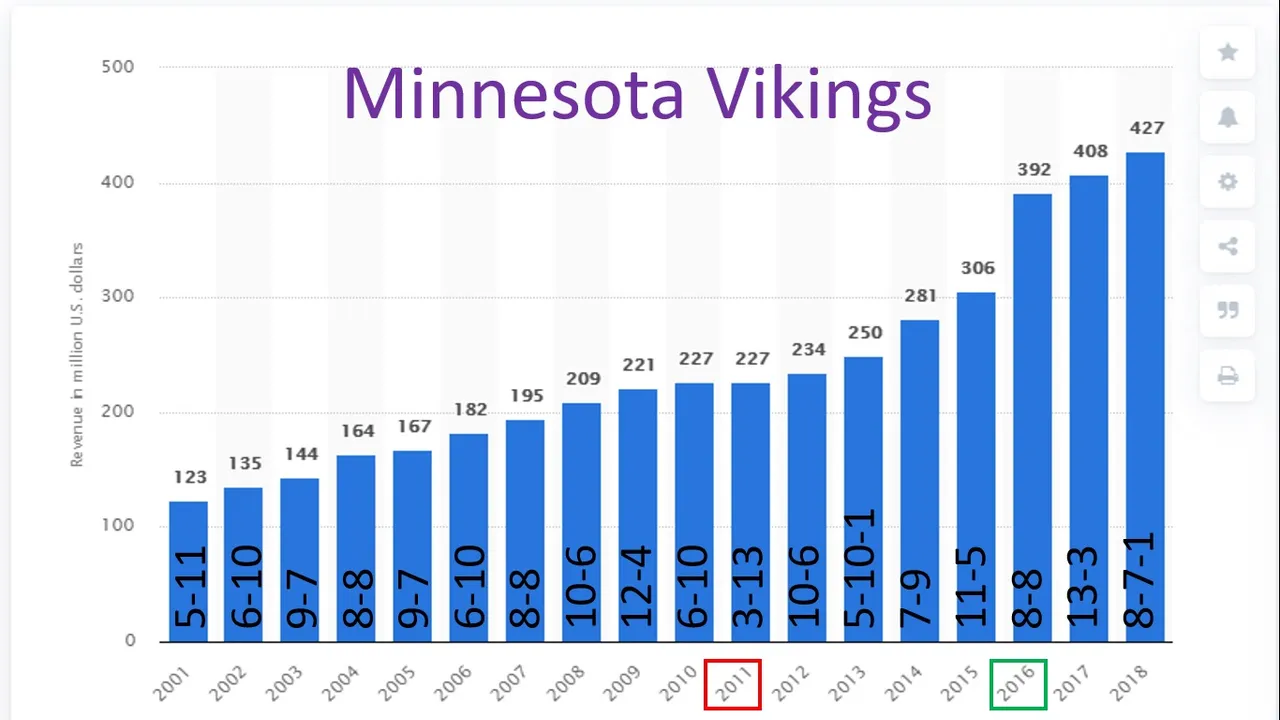
Source: Statista
Figure 6: Atlanta Falcons Revenue and Performance (2001 – 2018)
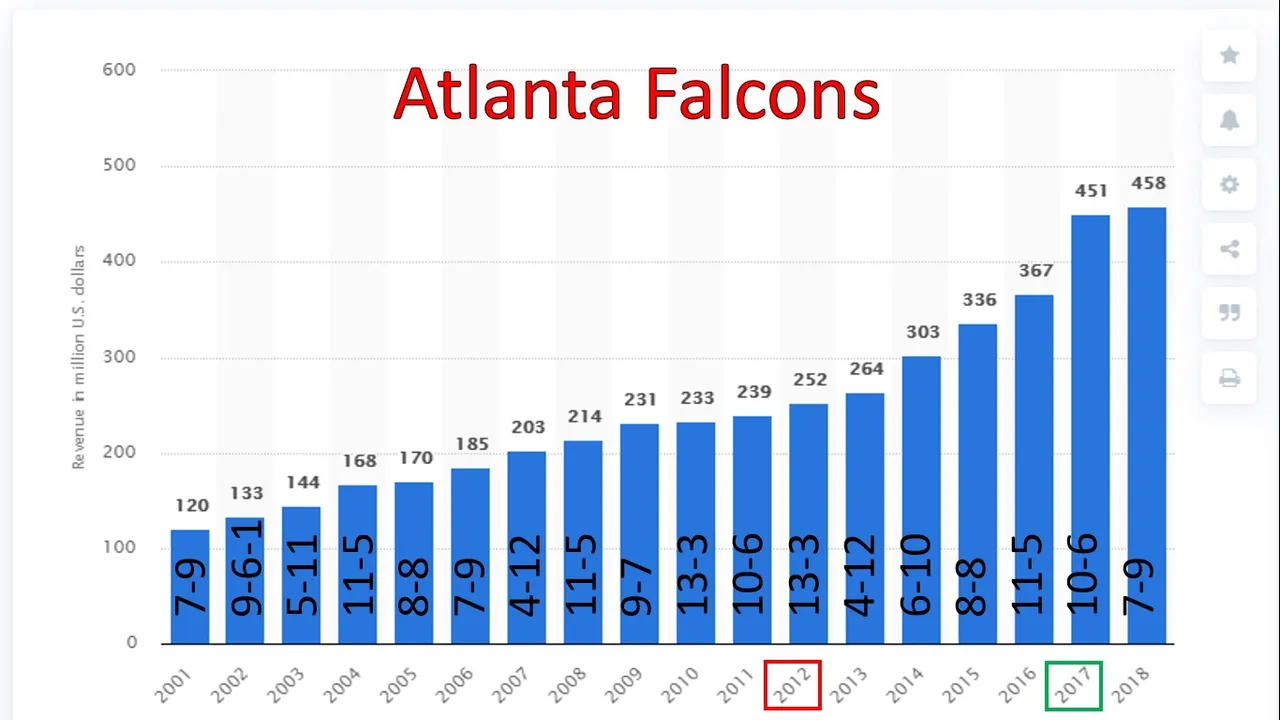
Source: Statista
Both the Vikings and Falcons experienced a jump of over 20% in revenue in the first year of the new stadium. The 49ers experienced a jump of almost 60% in revenue. The 49ers reached the playoffs three years in a row prior to the opening of their new stadium. They did not reach the playoffs for four years after the stadium was opened.
Building a new stadium should be considered an investment; therefore, the revenue of the team should increase. However, a large proportion of the funding for a new stadium comes the public. Since 1997, NFL teams have constructed 20 new stadiums, receiving an average of US$238 million per stadium in public funding (charleskochinstitute.org). Figure 7 contains the costs of 16 NFL stadiums built since 2000.
Figure 7: Construction costs of stadiums built after the year 2000
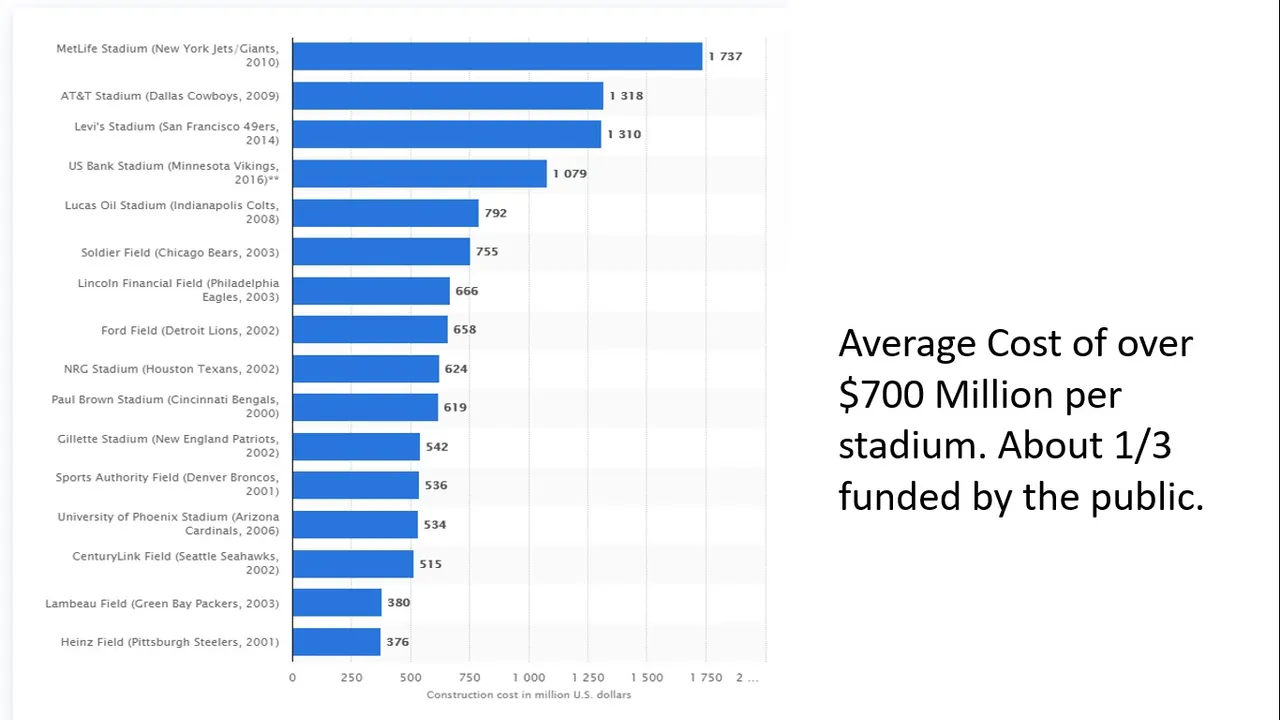
Source: Statista
Note: I could not find the difference in operating costs for the new stadiums compared to the old stadiums.
Another interesting point is that teams have generally performed quite well in the final year at their old stadiums. The 49ers, Vikings, and Falcons won at least 11 games in their final year. Could these good performances be a marketing ploy to increase fan support just before a new stadium opens? The Patriots won their first Super Bowl the year before their new stadium opened.
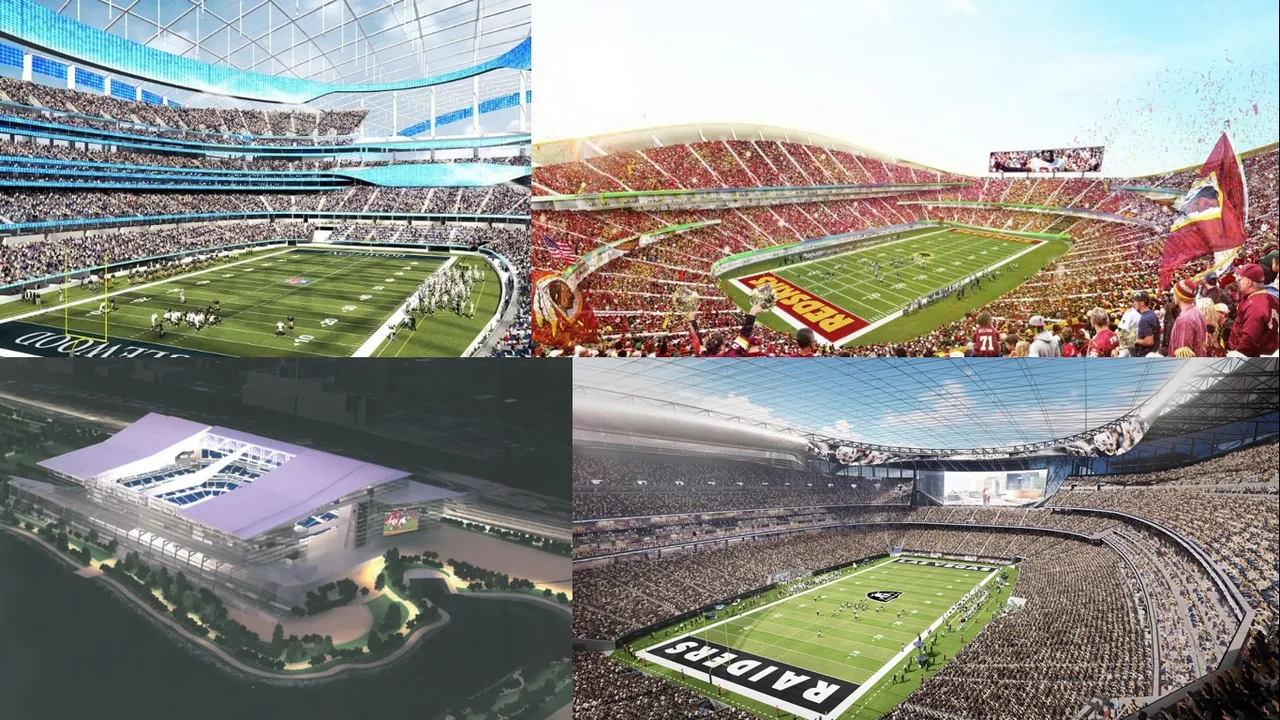
Several more stadiums have been proposed or are almost completed. These include stadiums for the Las Vegas Raiders, Washington Redskins, Los Angeles Rams, and Buffalo Bills. Could we see a surge in the performance of the Redskins and the Bills in the coming years? The Bills are looking like a good team with talented young quarterback Josh Allen.
How could games be fixed?
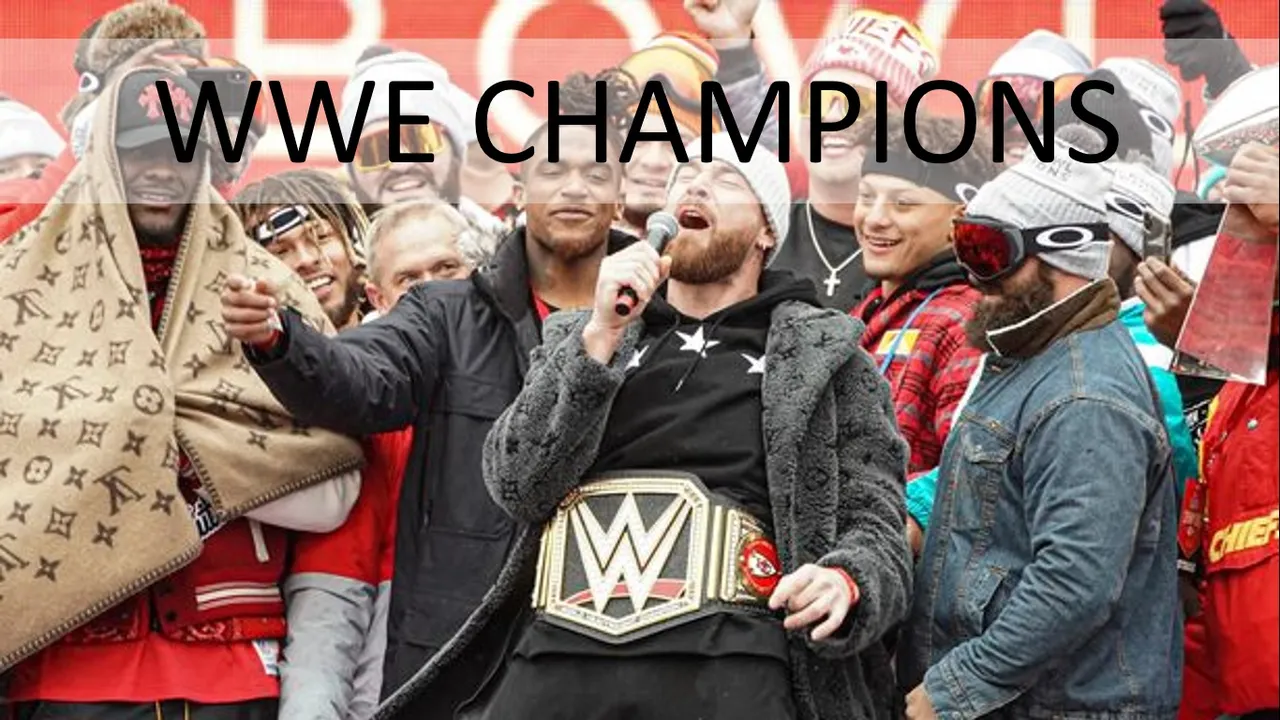
In 2017, I made the video Controlled Opposition Explained as a Game Theory Strategy, in this video I explained the idea of controlled opposition and how it could be applied to businesses, politics, and even sports. I did not get into much detail about any particular sport. In 2019, I wrote a post Building a winning team (Transitivity assumption) – Focus on the NFL, in this post I discussed how NFL teams could become more successful by creating favourable position matchups. I finished the post with a teaser about looking into the possibility of match fixing in the NFL. As the NFL season has just ended and many are claiming the Super Bowl and possibly even the season was rigged in favour of the Kansas City Chiefs, I thought I would discuss how match fixing could be possible.
A few days after the Super Bowl, a video about the referees fixing the Super Bowl became viral on YouTube. Below is a link to this video.
I recommend that you watch the video as the content creator points at several referee calls (Bill Vinovich was the referee for Super Bowl 54; he has been involved in a few other controversial games) that may have affected the outcome of the game. If the NFL is going to rig a game, the referees are in the best position to pull that off. The salary cap has made it difficult for any team to obtain a huge talent advantage over other teams. This has enabled referees to be able to sway the results of the game with just a few bad calls or no calls. Below, I have created a gif that highlights the bad calls and no calls on plays that could have changed the outcome of the game, enjoy.

I did not include any of the missed calls or no calls against the Chiefs, as I am not aware of any that could have changed the outcome of the game. However, there was a missed neutral zone infraction and several missed holding calls on run plays. There were no offensive holding penalties against either team throughout the entire game, which is very unusual even for a Super Bowl. The absence of offensive holding penalties is likely to favour the Chiefs, as the 49ers pass rush would be the key to stopping the Chiefs big play passing offense. Holding would allow the Chiefs wide receiver more time to become open deep downfield. Throughout the season, the 49ers had a positive net benefit from holding calls; ranked 6th (NFL penalties). The Chiefs had a negative net effect from holding calls; ranked 20th (NFL penalties).
Regardless of all the bad calls and no calls on penalties by the referees, the referees only played a part in the 49ers defeat. The other part and possibly bigger part, was played by the 49ers coaching decisions. The 49ers had the second best running game (ESPN) and a tight end with the second most receiving yards of any tight end in the league (Fantasy Football). They were facing a defence that was below average defending the run (Team Ranking) and one of the worst defending against tight ends (pro-football-reference.com). The 49ers coaching staff chose not to use the running back (Rasheem Mostert) who ran for 220 yards in the previous game until half way through the second quarter of the Super Bowl. They chose to use one of the best pass catching tight ends (George Kittle) as a blocker on many passing plays. Overall, the 49ers passed the ball almost 50% more than they ran it. These decisions are very strange and inconsistent with the way the team normally plays.
The 49ers clock management was terrible. The team wasted over a minute at the end of the first half when they could have scored points. The team did not use timeouts that could have been used to better prepare for a fourth down conversion late in the game. There were several passing plays where receivers ran to the same spot in the field. There was a play on the critical fourth quarter drive where all the receivers ran towards the middle of the field. This made defending easier and offered no opportunity for players to get out of bounds to stop the clock. There were many plays that George Kittle (when not pass blocking) was open but was not thrown the ball. This could have been because the quarterback missed him or it could have been the design of the play where he was a second or even a third option (quarterbacks look for receivers to become available in a particular order designed in the play or based on a pre-snap assessment). Below is a gif of some of the bad coaching decisions that contributed to this loss.
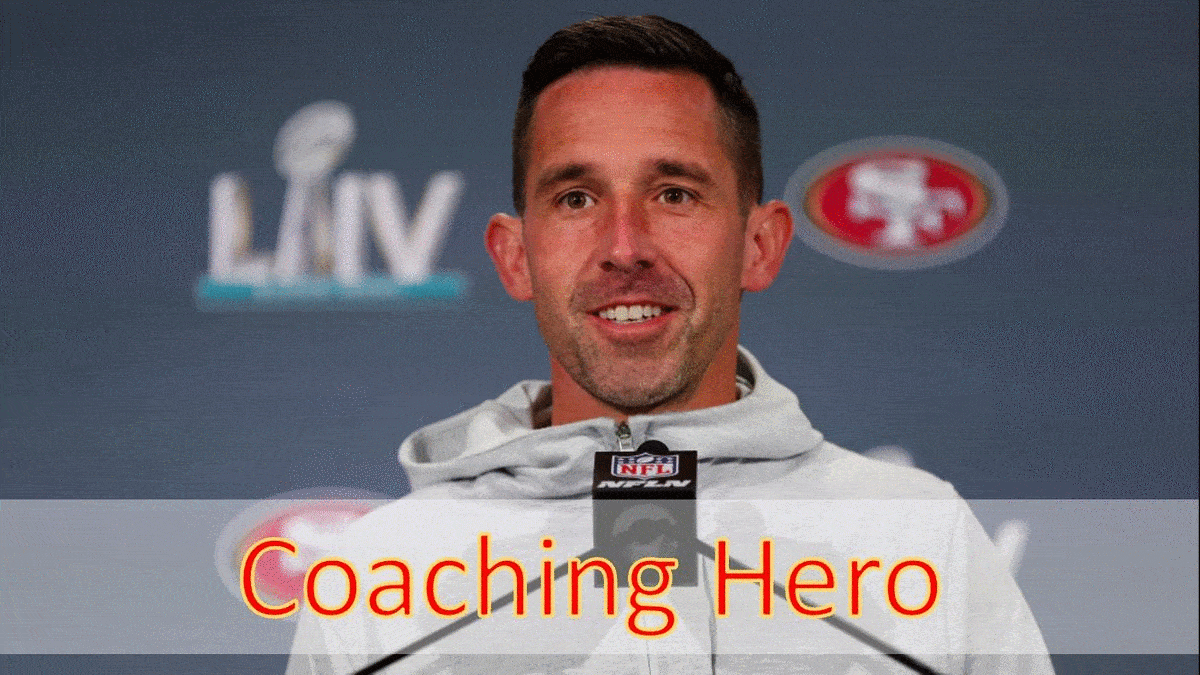
From the decisions made, it looks like the 49ers coaching staff may have intentionally sabotaged the Super Bowl for their team. I cannot definitively prove that this is the case. It is also possible that Kyle Shanahan (49ers head coach) completely choked. It seems hard to imagine that a coach of his calibre could make so many costly mistakes. His mistakes also reinforced some of the bad referee decisions.
Some could argue that 49ers quarterback (Jimmy Garoppolo) may have intentionally lost the game. However, I think he was trying to win but he was unable to compensate for bad coaching and referee decisions.
What role did the Chiefs play in this win?

The Kansas City Chiefs are a very good team. They have arguably the best pass catchers in the league and a top 10 quarterback who is only 24 years old. They also have a good running attack, which is underutilised and a defence that improved later in the year. However, they did not matchup well against the 49ers. The 49ers strengths aligned well with the Chiefs weaknesses. The Chiefs strengths (passing game) matched up against the 49ers greatest strength (pass defence). The Chiefs passing attack was abysmal for most of the game but their running game kept several drives alive with important 4th down conversations and several other first down conversions.

After 48 minutes of play, the Chiefs quarterback (Patrick Mahomes) had thrown for less than 200 yards, had thrown 2 interceptions, fumbled twice, had no passing touchdowns, and a quarterback rating of less than 50 (worst game of his career and one of the worst performances by a quarterback in Super Bowl history). This poor performance occurred despite not a single holding penalty against his team; thus giving him more time to throw. Even the 44 yard pass in the fourth quarter was only possible because of a missed holding penalty and a badly blown defensive assignment (Sorry Emmanuel Moseley, you missed this one). The pass went up like a punt rather than a pass and could have easily been intercepted if not for the defensive player being out of position.
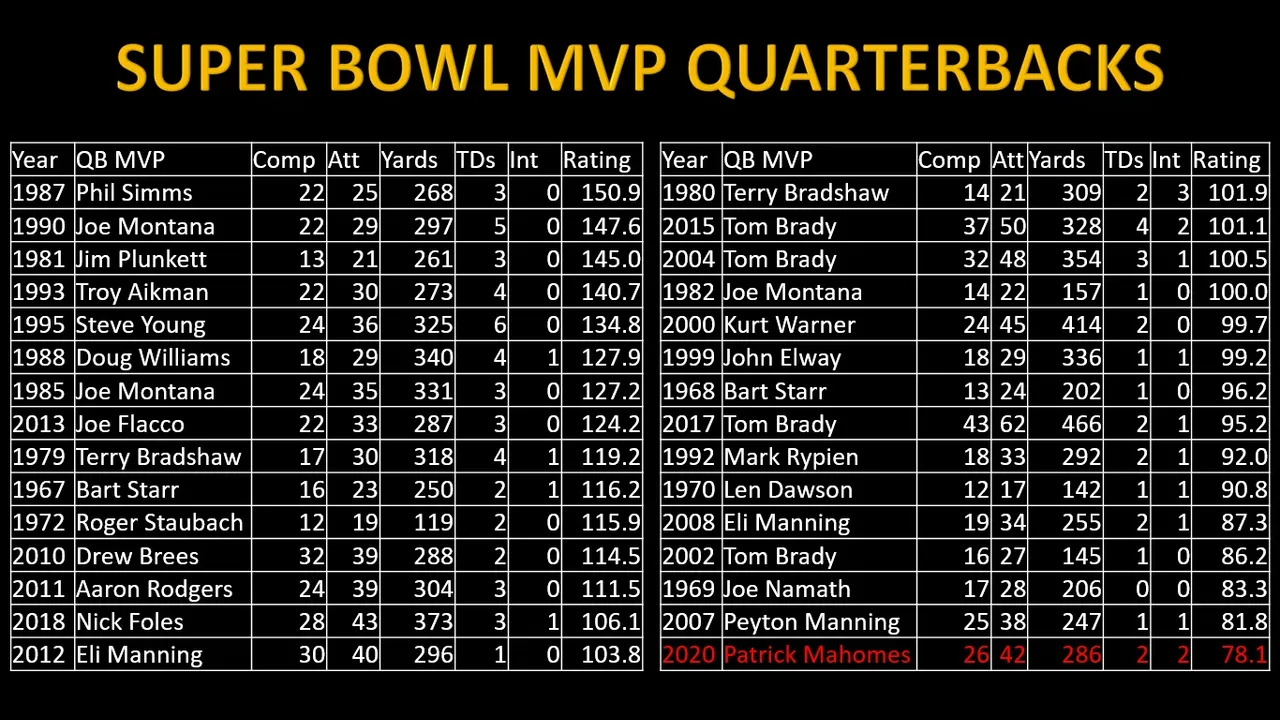
Even with inflated passing yards from missed calls and a touchdown that should have been disallowed, Patrick Mahomes was given the Super Bowl Most Valuable Player (MVP) award. His rating is the lowest of any quarterback to have been given this award in the Super Bowl’s 54 game history. Chief’s running back Damien Williams played an outstanding game. He rushed for over 100 yards, scored a touchdown and picked up critical first downs to keep several Chief drives alive. Defensive Tackle, Chris Jones, also played very well and was a disruptive force to the 49ers passing game by knocking down passes even when he was double-teamed by offensive linemen.
Entertaining Game
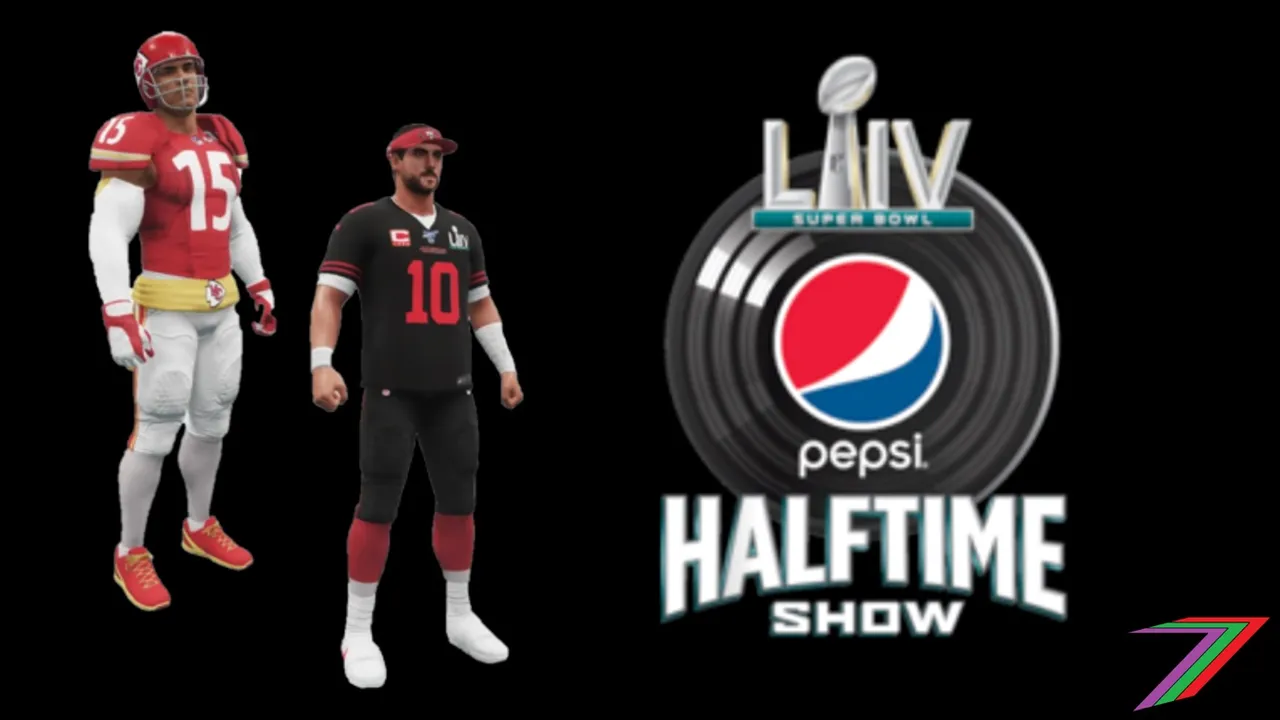
Super Bowl 54 was without doubt an entertaining game. It was mostly a close contest. There were good drives. There were innovative and exciting plays. The referees did not slow the game down with lots of penalties. There was an exciting late come from behind victory. There were exciting matchups, such as the best passing attack against the passing defence. The half time show was great. Super Bowl viewership was up, which is good for the NFL; see Figure 8.
Figure 8: Super Bowl Viewership
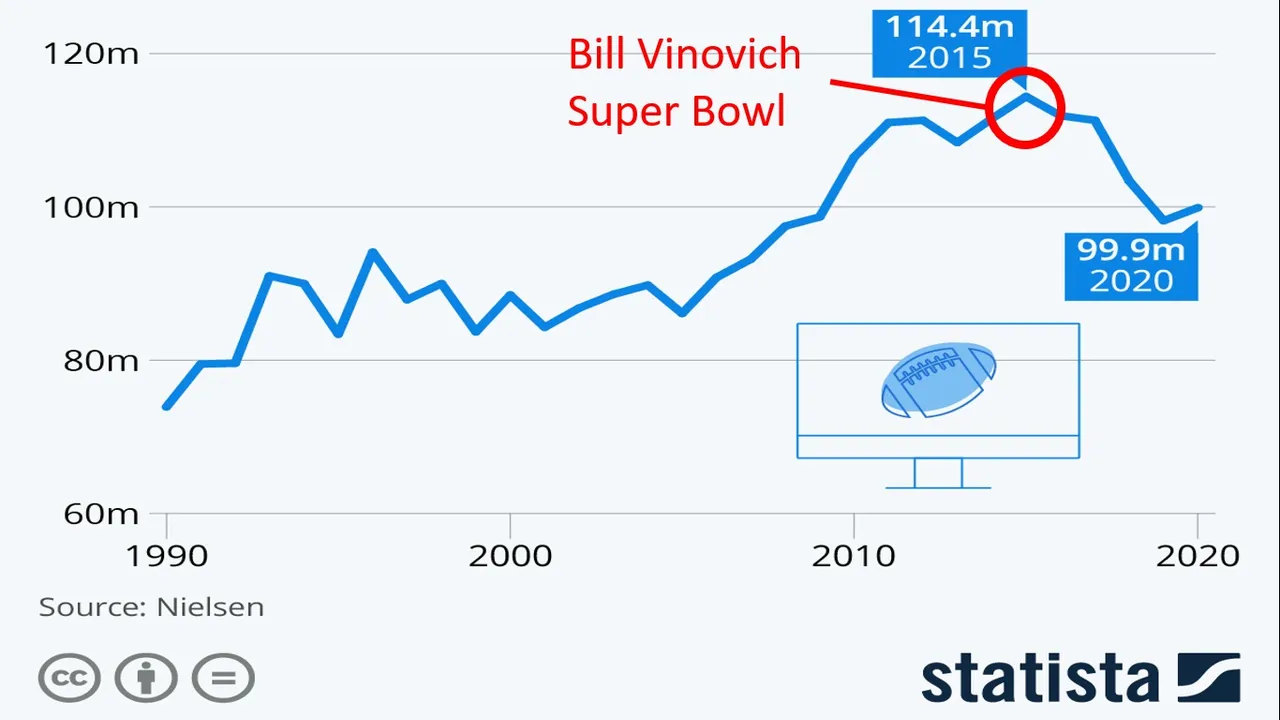
Source: Statista
I think most people were happy not to see the Patriots in the Super Bowl again. The Chiefs are a very exciting team and Patrick Mahomes is a very exciting player. From a business perspective, having the Chiefs in the Super Bowl is great. Patrick Mahomes is a very popular player and a good choice of MVP from a business perspective. There are several other young quarterbacks such as Lamar Jackson (Baltimore Ravens), Baker Mayfield (Cleveland Browns), Josh Allen (Buffalo Bills), Deshaun Watson (Houston Texans), and Kyler Murray (Arizona Cardinals), who will have their opportunities to shine in the coming years.
Big Business Downside
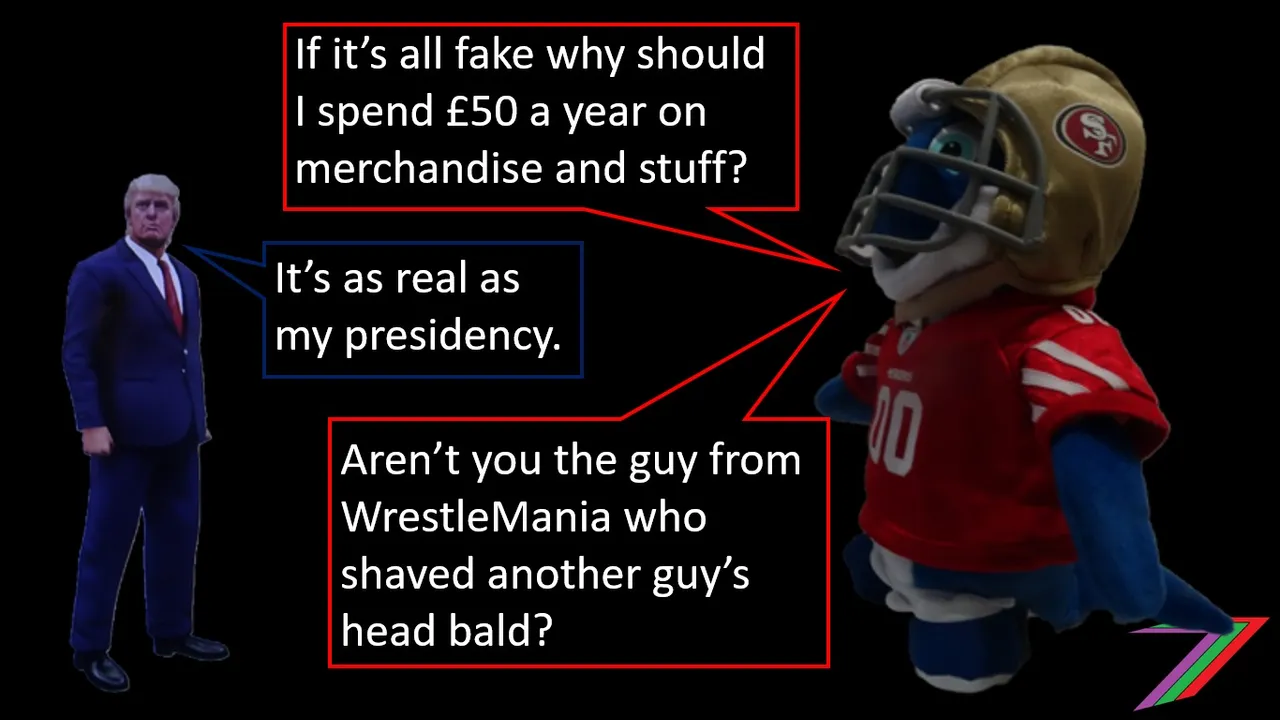
Match fixing may greatly increase the entertainment of games as well as create particular matchups in the playoffs and Super Bowl that people want but there is a risk of antagonising fans if the fixing is too obvious. Super Bowl 40, Pittsburgh Steelers vs. the Seattle Seahawks, is a game many fans believed was fixed. The referee even admitted making mistakes after the game (ESPN). However, I do not believe anyone admitted the game was fixed. Since that Super Bowl, concerns about match fixing has increased. I doubt Super Bowl 54 will be remembered in such a negative light but social media is abuzz with talk of referees fixing the game.
Many fans follow and support the NFL because they believe it is a genuine product and outcomes are based on the play of the game. If too many fans believe the game is fixed, the popularity of the NFL will fall and so will the revenue and profits. I believe most of what we see is real. However, I believe the NFL gives particular teams a slight nudge at times when it is good for business.
Final Opinion
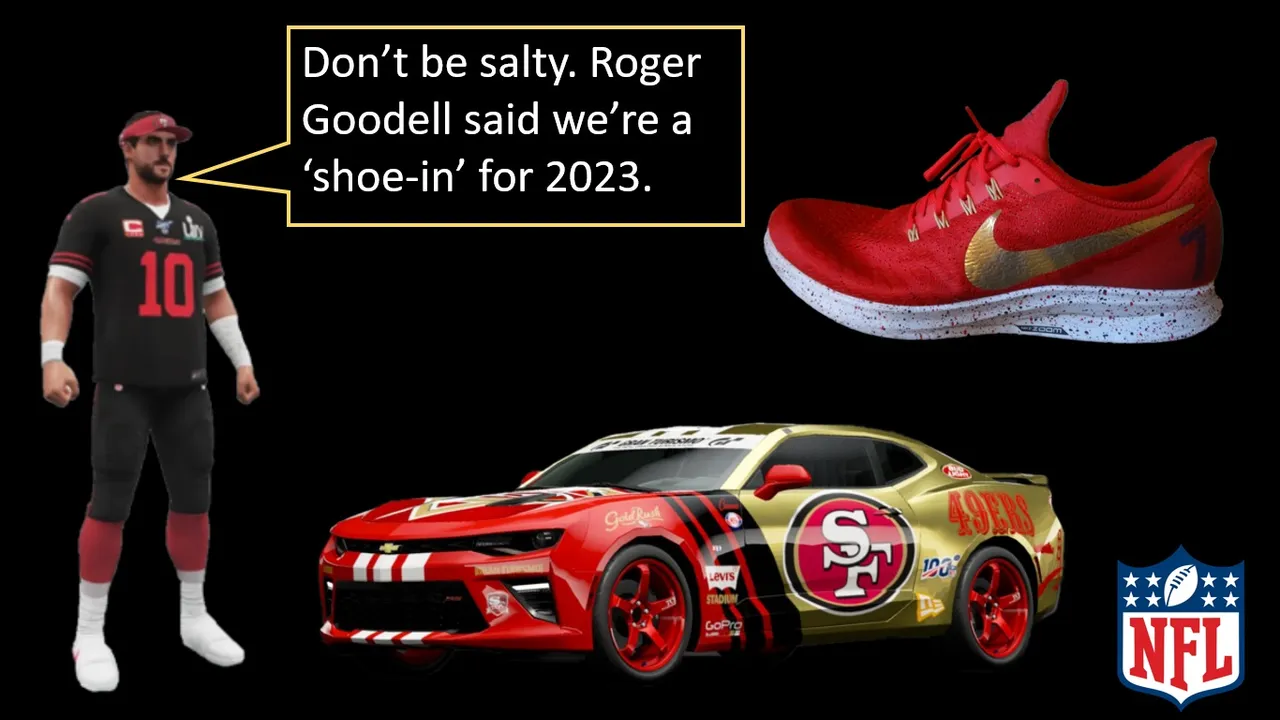
I enjoy American Football and I do not plan to stop watching it just because it is a little rigged at times. I understand the NFL works to maintain the profitability of the teams. This works well for all the teams in the long-run. I spend very little money on NFL merchandise and I do not live in the USA, therefore, my tax dollars are not being exploited to build new stadiums. I am a little disappointed the 49ers did not win the Super Bowl. Then again, if the referees had not missed the blatant pass interference in the Week 17 game against the Seahawks (thebiglead.com), the 49ers would, most likely, not have even reached the Super Bowl. See obvious pass interference. Below.
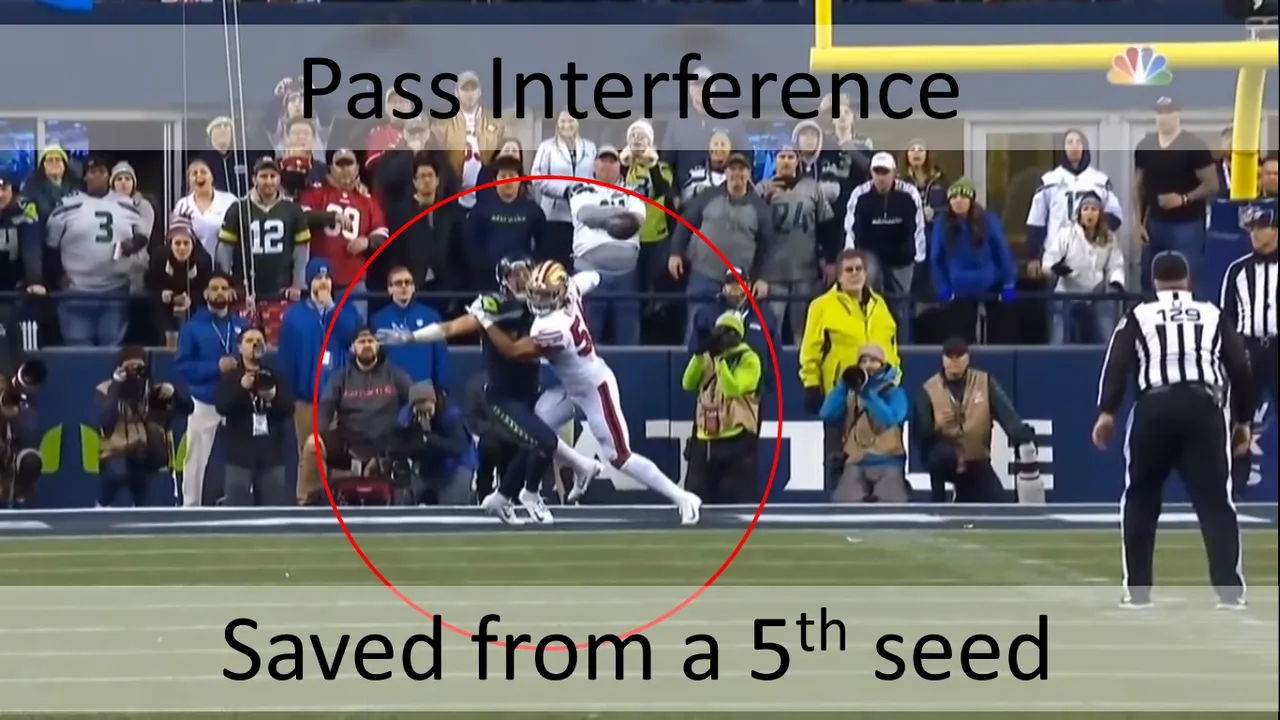
Just one more thing. The NFL created an NFL Christmas picture containing star players from each NFL team. At the front of the picture, two dogs greet Patrick Mahomes and George Kittle receives a dog as a Christmas present. These two players appear to be the only two wearing their team pants. See picture below.
NFL Christmas
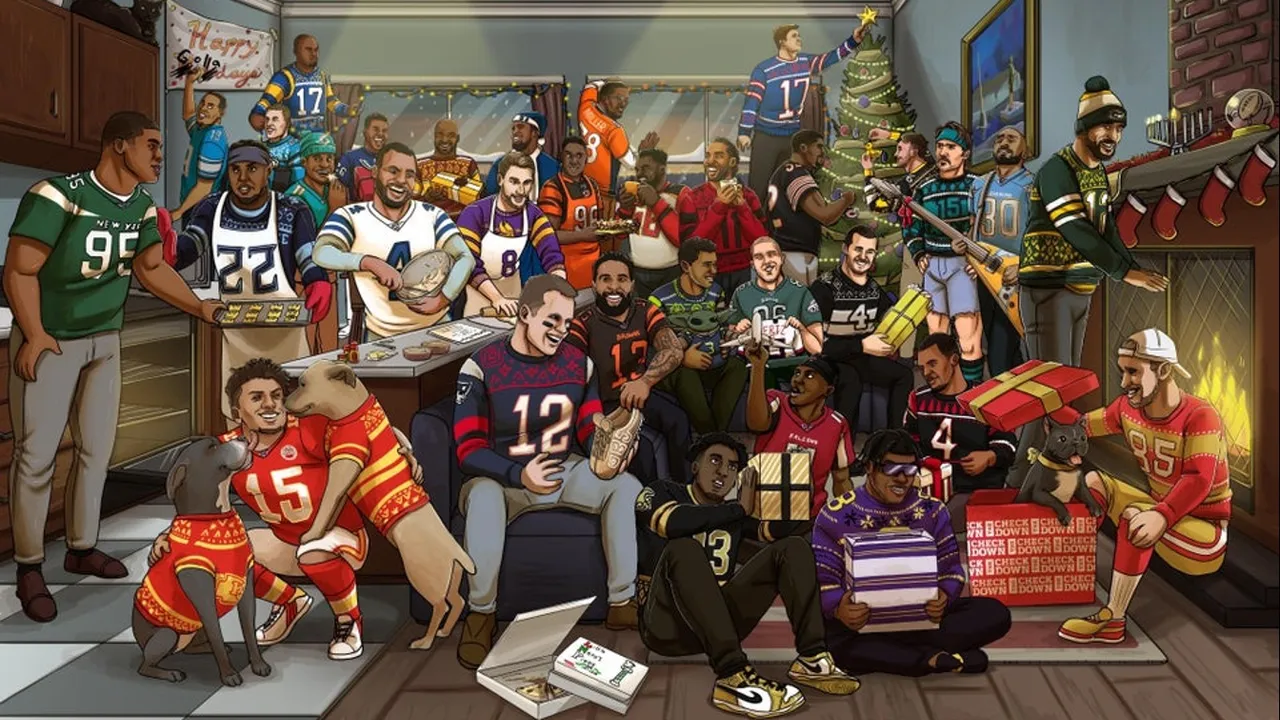
Is there hidden meaning to this picture? Were the NFL hiding their agenda in plain sight? It is easy to let our imagination be carried away as well as see things in a particular way in hindsight. I believe the same can be said for gematria relationships between names, numbers, dates, etc. I believe the most reliable approach is to analyse the decisions that reap the highest monetary rewards.
More posts

If you want to read any of my other posts, you can click on the links below. These links will lead you to posts containing my collection of works. These posts will be updated frequently.
Guide to the Steem Ecosystem (Udemy Course)
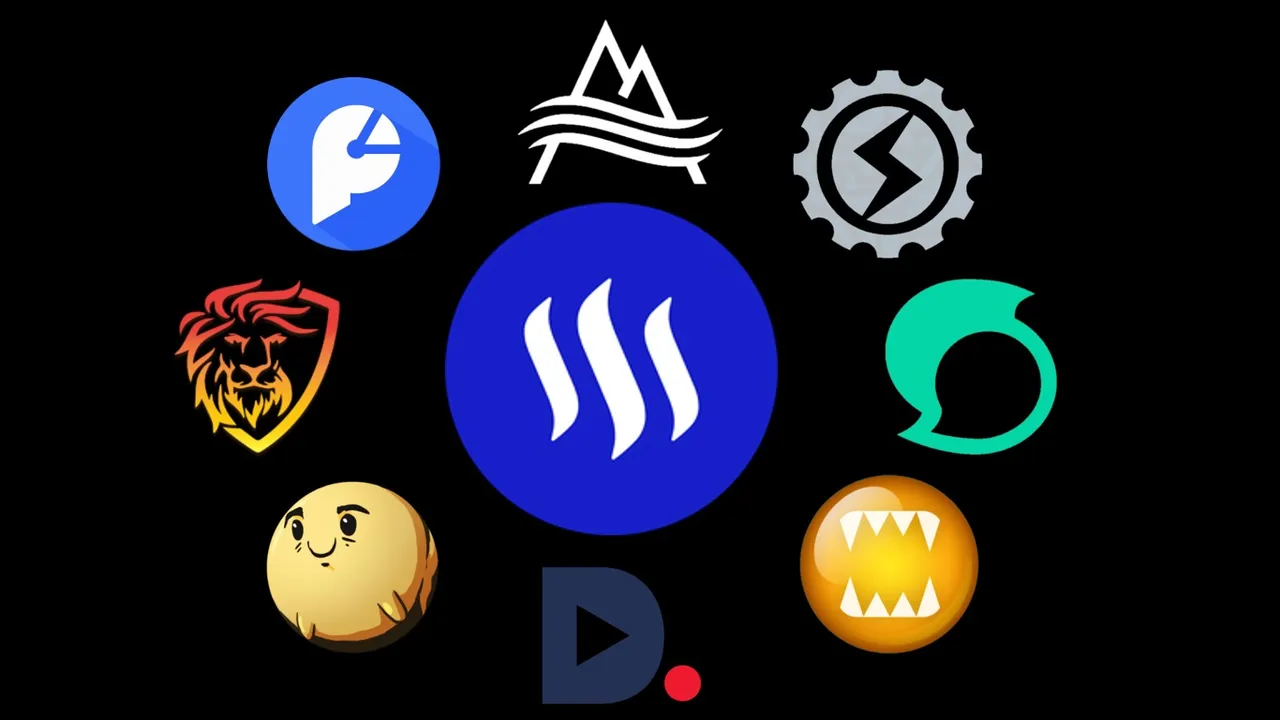
I have launched my Udemy course ‘Guide to the Steem Ecosystem’. This course takes you on journey through the Steem Ecosystem. The course consists of 6 sections. These sections are as follows:
- Getting Started
- Navigating Steem Frontends
- Becoming a Steem User
- Behind the Scenes
- The Wonders of the Steem Ecosystem
- Additional Content (SteemFest 4, SMTs, Communities, etc.)
The course contains 56 video lectures (about 13.5 hours of viewing), 56 multiple-choice questions (10 to 12 at the end of each section), and 59 downloadable resources (presentation slides and additional material such as white and blue papers). The course is free-of-charge. Click the link above to access the course.
I also have an economics course, titled Economics is for Everyone, which contains about 4 hours of video content.
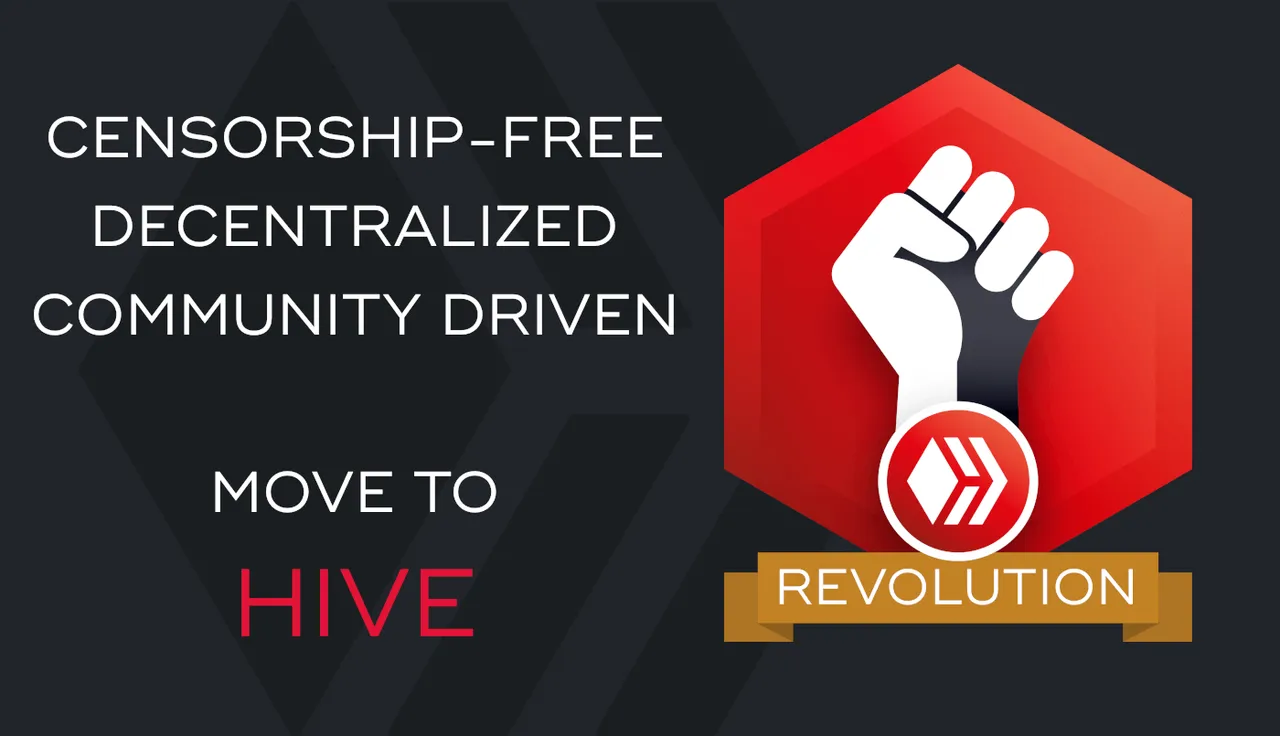


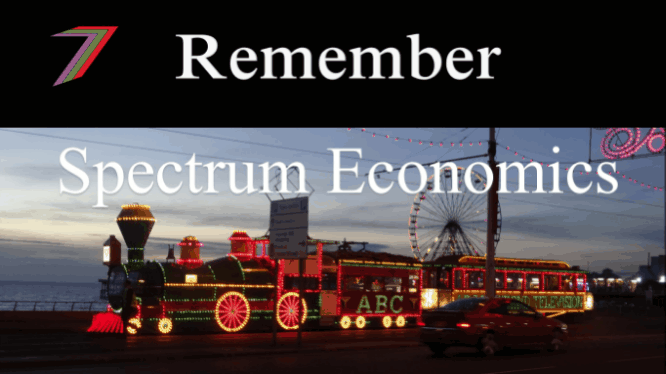
Steem - The Future of DApps

